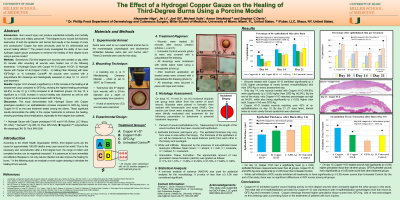Laboratory Research
(LR-020) The Effect of a Hydrogel Copper Gauze on the Healing of Third-Degree Burns Using a Porcine Model.
Friday, April 28, 2023
7:15 PM - 8:30 PM East Coast USA Time

Jie Li, MD, PhD – Associate Professor, Dr. Phillip Frost Department of Dermatology and Cutaneous Surgery, University of Miami, Miller School of Medicine. Dr. Phillip Frost Department of Dermatology and Cutaneous Surgery; Joel Gil, BS – Sr. Manager, Research Laboratory, Dr. Phillip Frost Department of Dermatology and Cutaneous Surgery, University of Miami, Miller School of Medicine. Dr. Phillip Frost Department of Dermatology and Cutaneous Surgery; Michael Solis, MBA – Research Associate 2, Dr. Phillip Frost Department of Dermatology and Cutaneous Surgery, University of Miami, Miller School of Medicine. Dr. Phillip Frost Department of Dermatology and Cutaneous Surgery; Aaron Strickland, PhD – Vice President of Research and Development, iFyber, LLC; Stephen Davis, BS – Research Professor, Dr. Phillip Frost Department of Dermatology and Cutaneous Surgery, University of Miami, Miller School of Medicine. Dr. Phillip Frost Department of Dermatology and Cutaneous Surgery
Introduction: Burn wound injury can produce substantial morbidity and mortality for both civilians and military personnel. 1 Third-degree burns include full thickness destruction of both the epidermis and dermis that results in the develop of scars and contractures.2 Copper has been previously used for it’s antimicrobial and wound healing effects. 3,4 The present study investigated the ability of two novel hydrogel copper gauze prototypes to enhance the healing of third degree burns using a porcine model.5
Methods: Seventy-two (72) third degree burn wounds were created on pig, within 20 minutes after wounding all wounds were treated one of the following treatments: 1) Hydrogel Gauze with Copper H1-D (Copper H1-D)^, 2) Hydrogel Gauze with Copper H1-B (Copper H1-B)+, 3) Gelling Fiber Dressing with silver (GFD-Ag)*, or 4) Untreated Control. All wounds were covered with a polyurethane film dressings and histologically assessed on days 10, 14 and 21 post treatment.
Results: Copper H1-D showed a significant (p≤0.05) increase in the healing at all assessment days compared to GFD-Ag, showing the highest healing percentage (84.8%) on day 21 (p ≤ 0.05) compared to all tretaments groups. On day 10 a significant (p≤0.05) increase in wound healing was observed as well with Copper H1-B compared to wounds treated with GFD-Ag.
Discussion: This study demonstrate that the both Hydrogel Gauze with Copper prototypes resulted in a increase in ephilialization compared to GFD-Ag, having Copper H1-D as a best treatment tested amount the others. These significant results demonstrate the ability of the copper treatments to enhance the healing, showing a promising clinical implications, especially for third degree burn patients.
Methods: Seventy-two (72) third degree burn wounds were created on pig, within 20 minutes after wounding all wounds were treated one of the following treatments: 1) Hydrogel Gauze with Copper H1-D (Copper H1-D)^, 2) Hydrogel Gauze with Copper H1-B (Copper H1-B)+, 3) Gelling Fiber Dressing with silver (GFD-Ag)*, or 4) Untreated Control. All wounds were covered with a polyurethane film dressings and histologically assessed on days 10, 14 and 21 post treatment.
Results: Copper H1-D showed a significant (p≤0.05) increase in the healing at all assessment days compared to GFD-Ag, showing the highest healing percentage (84.8%) on day 21 (p ≤ 0.05) compared to all tretaments groups. On day 10 a significant (p≤0.05) increase in wound healing was observed as well with Copper H1-B compared to wounds treated with GFD-Ag.
Discussion: This study demonstrate that the both Hydrogel Gauze with Copper prototypes resulted in a increase in ephilialization compared to GFD-Ag, having Copper H1-D as a best treatment tested amount the others. These significant results demonstrate the ability of the copper treatments to enhance the healing, showing a promising clinical implications, especially for third degree burn patients.

.png)
